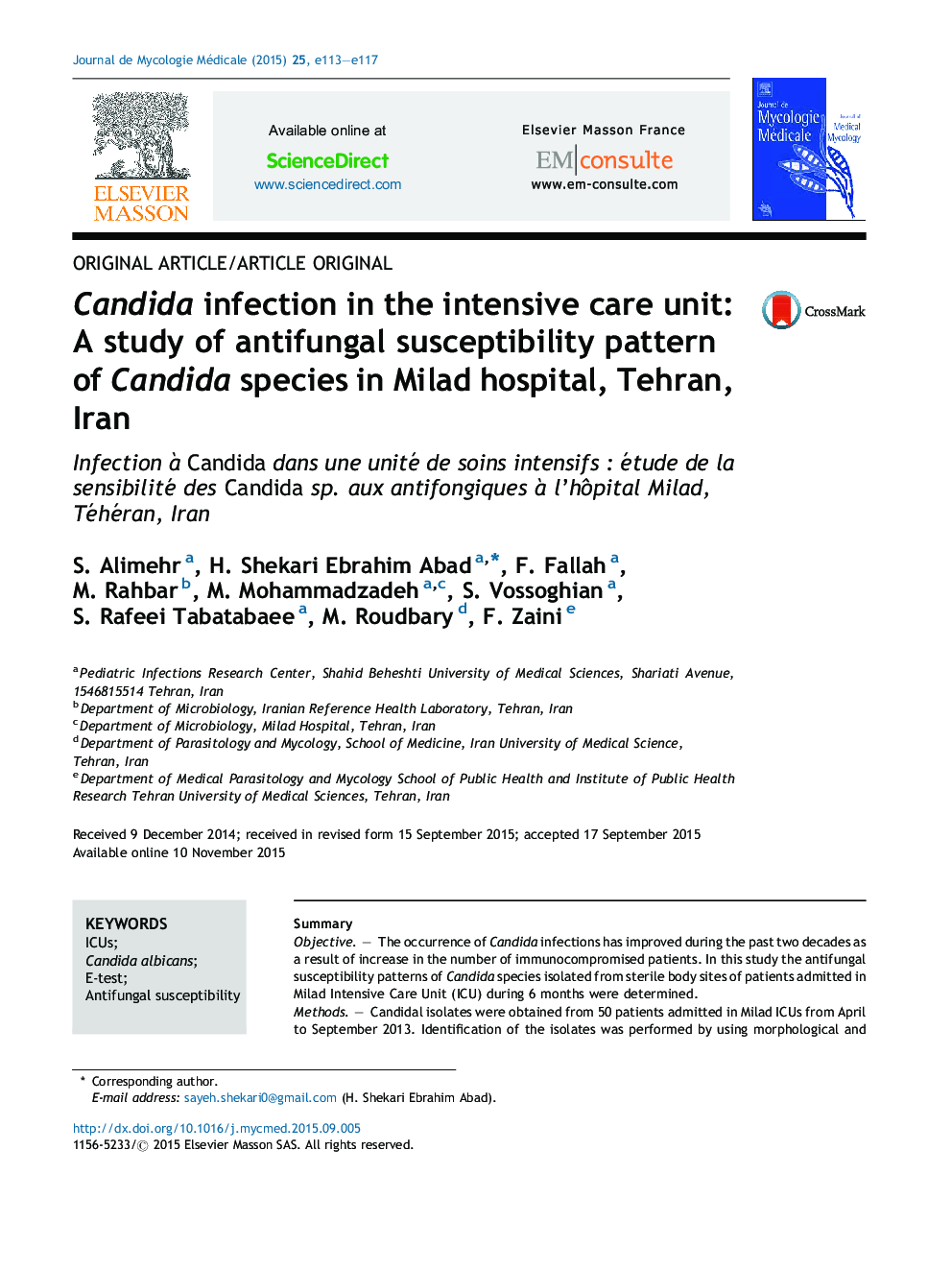| کد مقاله | کد نشریه | سال انتشار | مقاله انگلیسی | نسخه تمام متن |
|---|---|---|---|---|
| 3219068 | 1204441 | 2015 | 5 صفحه PDF | دانلود رایگان |
SummaryObjectiveThe occurrence of Candida infections has improved during the past two decades as a result of increase in the number of immunocompromised patients. In this study the antifungal susceptibility patterns of Candida species isolated from sterile body sites of patients admitted in Milad Intensive Care Unit (ICU) during 6 months were determined.MethodsCandidal isolates were obtained from 50 patients admitted in Milad ICUs from April to September 2013. Identification of the isolates was performed by using morphological and polymerase chain reaction assay. Resistance to the antifungal agents containing caspofungin, posoconazole, voriconazole and amphotericin B was determined using E-test method.ResultsOut of 67 Candida isolates 47.8% were Candida glabrata, 28.3% were C. albicans, 7.5% were C. tropicalis, 7% were C. guilliermondii, 3% were C. krusei and 2% were C. dubliniensis. C. glabrata was the least susceptible species, with 9.4% of the isolates resistant to amphotericin B and 6.3% resistant to posoconazole and voriconazole. No resistance to caspofungin was observed among C. glabrata isolates. One of the C. krusei isolates was resistant to amphotericin B while no resistance to voriconazole, caspofungin and posoconazole was detected among C. krusei strains. Increase in the prevalence of antifungal-resistant non-C. albicans species in recent years has become a problematic event amongst clinicians caring for ICU patients. C. glabrata as the most common species isolated from ICU patients in this study indicated higher levels of antifungal resistance in comparison with other species. This observation accentuates the importance of managing preventive treatments to avoid development of resistance to the current antifungal drugs.
RésuméObjectifLa survenue d’infections à Candida s’est accrue au cours des deux dernières décennies en raison de l’augmentation du nombre de patients immunodéprimés. Dans cette étude, les profils de sensibilité aux antifongiques des espèces de Candida isolées à partir de sites corporels stériles de patients admis en unité de soins intensifs Milad (USI) pendant 6 mois ont été déterminés.MéthodesLes Candida isolats ont été obtenus à partir de 50 patients admis dans les unités de soins intensifs Milad d’avril à septembre 2013. L’identification des isolats a été réalisée en utilisant la réaction en chaîne polymérase et les tests morphologiques. La résistance aux agents antifongiques, caspofungine, posoconazole, voriconazole et amphotéricine B, a été déterminée en utilisant la méthode E-test.RésultatsSur 67 Candida isolés 47,8 % étaient Candida glabrata, 28,3 % étaient C. albicans, 7,5 % étaient C. tropicalis, 7 % étaient C. guilliermondii, 3 % étaient C. krusei et 2 % étaient C. dubliniensis. C. glabrata était l’espèce la moins sensible, avec 9,4 % des isolats résistants à l’amphotéricine B et 6,3 % résistants à posoconazole et voriconazole. Aucune résistance à la caspofungine a été observée chez C. glabrata. Un des isolats C. krusei était résistant à l’amphotéricine B, tandis qu’aucune résistance à voriconazole, caspofungine et posoconazole a été détectée parmi les souches C. krusei. L’augmentation de la prévalence des antifongiques résistants dans les espèces non C. albicans au cours des dernières années est devenue un événement problématique parmi les cliniciens qui soignent des patients en soins intensifs. C. glabrata, étant l’espèce la plus commune isolée à partir de patients en soins intensifs dans cette étude, a indiqué des niveaux plus élevés de résistance antifongique en comparaison avec d’autres espèces. Cette observation accentue l’importance de la gestion des traitements préventifs pour éviter le développement de la résistance aux médicaments antifongiques actuels.
Journal: Journal de Mycologie Médicale / Journal of Medical Mycology - Volume 25, Issue 4, December 2015, Pages e113–e117
